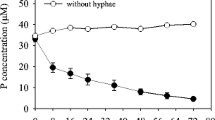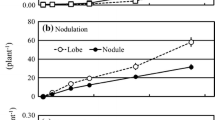Summary
Wheat seedlings, treated with the auxine 2,4-dichlor-phenoxy acetic acid (2,4-D) during germination developed only a residual root system. Root elongation was extremely restricted and root tips were deformed to thick club-shaped tumours. When 2,4-D was added in a later stage of plant growth the plants developed additional nodule-like knots along primary roots. Root and shoot dry-matter production was slightly repressed in all 2,4-D treatments and N translocation from roots to shoots was repressed as well. When transferred to an auxine-free growth medium, the 2,4-D-affected roots were not capable of complete recovery. In plants inoculated gnotobiotically with Azospirillum brasilense, either with the wild type or with the NH +4 -excreting mutant strain C3, a 2,4-D addition increased rhizosphere acetylene-reduction activity at pO2 1.5 kPa. The O2 sensitivity of root-associated nitrogenase activity tended to be reduced. The number of root-colonizing bacteria, at approximately 108 colony-forming units (cfu) per g dry root, was similar in the 2,4-D treatments and untreated controls. Plant treatment with high concentrations of the chemical isomer 3,5-dichlor-phenoxy acetic acid (3,5-D) did not have comparable effects, either on plant development or on rhizosphere-associated nitrogenase activity. Root-tumour tissue inhabited by A. brasilense showed purple staining when subjected to a tetrazolium chloride solution, which may indicate intensive local nitrogenase activity in this tissue. Exposed to an 15N2-enriched atmosphere, plants treated with 2,4-D and with A. brasilense incorporated significantly higher amounts of 15N than untreated controls. In all cases the highest values of 15N enrichment were found following inoculation with the NH +4 -excreting mutant strain C3.
Similar content being viewed by others
References
Bashan Y, Levanony H (1988) Interaction between Azospirillum brasilense CD and wheat root cells during early stages of root colonization. In: Klingmüller W (ed) Azospirillum IV. Springer Verlag, Berlin, pp 166–173
Bender GL, Preston L, Bernard D, Rolfe BG (1990) Formation of nodule-like structures on the roots of the non-legumes rice and wheat. In: Gresskoff PM, Roith G, Stacey G, Newton WE (eds) Nitrogen fixation: Achievements and objectives. Chapman and Hall, New York, p 825
Christiansen-Weniger C (1988) An influence of plant growth substances on growth and nitrogenase activity from Azospirillum brasilense. In: Klingmüller W (ed) Azospirillum IV. Springer Verlag, Berlin, pp 141–149
Christiansen-Weniger C, Van Veen JA (1991a) Nitrogen fixation by Azospirillum brasilense in soil and the rhizosphere under controlled environmental conditions. Biol Fertil Soils 12:100–106
Christiansen-Weniger C, Van Veen JA (1991b) NH +4 -excreting Azospirillum brasilense mutants enhance the nitrogen supply of a wheat host. Appl Environ Microbiol 57:3006–3012
Christiansen-Weniger C, Boddey RM, Döbereiner J (1985) Evaluation of nitrogen fixation in sorghum cultivars inoculated with different strains of Azospirillum spp. In: Klingmüller W (ed) Azospirillum III. Springer Verlag, Berlin pp 180–188
Christiansen-Weniger C, Groneman AF, Van Veen JA (1992) Associative N2-fixation and root exudation of organic acids from wheat cultivars of different aluminium tolerance. Plant and Soil 139:167–174
Fahreus G (1957) The infection of clover root hairs by nodule bacteria studied by a simple glass slide technique. J Gen Microbiol 16:374–381
Hartmann A, Kleiner D (1982) Ammonium (methylammonium) transport by Azospirillum spp. FEMS Microbiol Lett 15:65–67
Kotte W (1922) Wurzelmeristem in Gewebekultur, Ber Deut Bot Ges 40:269–272
Machado HB, Fumayama S, Rigo LV, Pedrosa FO (1991) Excretion of ammonium by Azospirillum brasilense mutants resistant to ethylenediamine. Can J Microbiol 37:549–553
Moore TC (1989) Biochemistry and physiology of plant hormones. Springer Verlag, Berlin
Nap JP, Bisseling T (1990) Development biology of a plant-procariote symbiosis: The legume root nodule. Science 250:948–954
Nayak PNM, Ladha JK, Watanabe I (1986) The fate of marker Azospirillum lipoferum inoculated into rice and its effect on growth, yield and N2-fixation studied by acetylen reduction, 15N2-feeding and 15N-dilution technique. Biol Fertil Soils 2:7–14
Nie YF (1983) Nature Journal (Chinese) 6:326
Nie YF, Tang PC, Bei ST (1986) J Microbiol (Chinese) 6:6–8
Nur I, Okon Y, Henis Y (1980) An increase in nitrogen content of Setaria italica and Zea mays inoculated with Azospirillum. Can J Microbiol 26:482–485
Okon Y, Heitler PG, Hardy R (1983) N2-fixation by Azospirillum brasilense and its incorporation into the host Setaria italica. Appl Environ Microbiol 46:695–697
Patriquin DG, Döbereiner J (1978) Light microscopy observation of tetrazolium-reducing bacteria in the endorhizosphere of maize and other grasses in Brazil. Can J Microbiol 24:734–742
Rolfe BG, Gresshoff PM (1988) Genetic analysis of legume nodule initiation. Annu Rev Plant Physiol Plant Mol Biol 39:297–319
Tchan YT, Kennedy IR (1989) Possible N2-fixing root nodules induced in non-legumes. Agric Sci (Melbourne) 2:57–59
Tchan YT, Zeman AMM, Kennedy IR (1991) Nitrogen fixation in paranodules of wheat roots by introduced free living diazotrophs. Plant and Soil 137:43–47
Watanabe I, Lin C (1983) Response of wetland rice to inoculation with Azospirillum lipoferum and Pseudomonas sp. Soil Sci Plant Nutr 30:117–124
Whallon JH, Acker G, El-Khawas H (1985) Electron microscopy of young wheat roots inoculated with Azospirillum. In: Klingmüller W (ed) Azospirillum III. Springer Verlag, Berlin, pp 221–229
Author information
Authors and Affiliations
Additional information
Present address: F. A. Janssens Laboratory of Genetics, Catholic University of Leuven, Willem de Croylan 42, B-3001 Heverlee, Belgium
Rights and permissions
About this article
Cite this article
Christiansen-Weniger, C. N2-fixation by ammonium-excreting Azospirillum brasilense in auxine-induced root tumours of wheat (Triticum aestivum L.). Biol Fertil Soils 13, 165–172 (1992). https://doi.org/10.1007/BF00336274
Received:
Issue Date:
DOI: https://doi.org/10.1007/BF00336274




